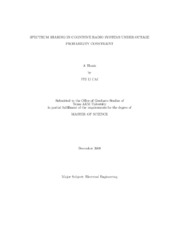| dc.contributor.advisor | Cui, Shuguang | |
| dc.creator | Cai, Pei Li | |
| dc.date.accessioned | 2011-02-22T22:24:02Z | |
| dc.date.accessioned | 2011-02-22T23:47:11Z | |
| dc.date.available | 2011-02-22T22:24:02Z | |
| dc.date.available | 2011-02-22T23:47:11Z | |
| dc.date.created | 2009-12 | |
| dc.date.issued | 2011-02-22 | |
| dc.date.submitted | December 2009 | |
| dc.identifier.uri | https://hdl.handle.net/1969.1/ETD-TAMU-2009-12-7463 | |
| dc.description.abstract | For traditional wireless communication systems, static spectrum allocation is
the major spectrum allocation methodology. However, according to the recent investigations
by the FCC, this has led to more than 70 percent of the allocated spectrum in the
United States being under-utilized. Cognitive radio (CR) technology, which supports
opportunistic spectrum sharing, is one idea that is proposed to improve the overall
utilization efficiency of the radio spectrum.
In this thesis we consider a CR communication system based on spectrum sharing
schemes, where we have a secondary user (SU) link with multiple transmitting antennas
and a single receiving antenna, coexisting with a primary user (PU) link with
a single receiving antenna. At the SU transmitter (SU-Tx), the channel state information
(CSI) of the SU link is assumed to be perfectly known; while the interference
channel from the SU-Tx to the PU receiver (PU-Rx) is not perfectly known due to
less cooperation between the SU and the PU. As such, the SU-Tx is only assumed to
know that the interference channel gain can take values from a finite set with certain
probabilities. Considering a SU transmit power constraint, our design objective is to
determine the transmit covariance matrix that maximizes the SU rate, while we protect
the PU by enforcing both a PU average interference constraint and a PU outage
probability constraint. This problem is first formulated as a non-convex optimization
problem with a non-explicit probabilistic constraint, which is then approximated as
a mixed binary integer programming (MBIP) problem and solved with the Branch and Bound (BB) algorithm. The complexity of the BB algorithm is analyzed and numerical
results are presented to validate the eff ectiveness of the proposed algorithm.
A key result proved in this thesis is that the rank of the optimal transmit covariance
matrix is one, i.e., CR beamforming is optimal under PU outage constraints.
Finally, a heuristic algorithm is proposed to provide a suboptimal solution to our
MBIP problem by efficiently (in polynomial time) solving a particularly-constructed
convex problem. | en |
| dc.format.mimetype | application/pdf | |
| dc.language.iso | en_US | |
| dc.subject | Cognitive Radio (CR), Spectrum Sharing, Convex Optimization, Branch and Bound, Probabilistic Constraint, Integer Programming. | en |
| dc.title | Spectrum Sharing in Cognitive Radio Systems Under Outage Probablility Constraint | en |
| dc.type | Book | en |
| dc.type | Thesis | en |
| thesis.degree.department | Electrical and Computer Engineering | en |
| thesis.degree.discipline | Electrical Engineering | en |
| thesis.degree.grantor | Texas A&M University | en |
| thesis.degree.name | Master of Science | en |
| thesis.degree.level | Masters | en |
| dc.contributor.committeeMember | Pfister, Henry | |
| dc.contributor.committeeMember | Li, Peng | |
| dc.contributor.committeeMember | Rojas, Joseph M. | |
| dc.type.genre | Electronic Thesis | en |
| dc.type.material | text | en |


